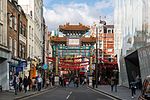Leicester House, Westminster
Buildings and structures demolished in 1791Demolished buildings and structures in LondonFormer houses in the City of WestminsterHistory of the City of WestminsterHouses completed in the 17th century ... and 1 more
Leicester Square

Leicester House was a large aristocratic townhouse in Westminster, London, to the north of where Leicester Square now is. Built by the Earl of Leicester and completed in 1635, it was later occupied by Elizabeth Stuart, a former Queen of Bohemia, and by the Hanoverian Princess of Wales. From 1775 to 1788, the Leverian collection was on display in Leicester House. The house was sold and demolished in 1791.
Excerpt from the Wikipedia article Leicester House, Westminster (License: CC BY-SA 3.0, Authors, Images).Leicester House, Westminster
Leicester Square, London Covent Garden
Geographical coordinates (GPS) Address Nearby Places Show on map
Geographical coordinates (GPS)
| Latitude | Longitude |
|---|---|
| N 51.511111111111 ° | E -0.13055555555556 ° |
Address
Number One Leicester Square
Leicester Square 1-4
WC2H 7NA London, Covent Garden
England, United Kingdom
Open on Google Maps







